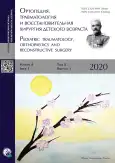儿童脑膜炎球菌感染的骨科后果:上肢和下肢畸形的矫正选择 (初步报告)
- 作者: Garkavenko Y.E.1,2, Khodorovskaya A.M.1, Dolgiev B.H.1, Melchenko E.V.1
-
隶属关系:
- H. Turner National Medical Research Center for Сhildren’s Orthopedics and Trauma Surgery
- North-Western State Medical University named after I.I. Mechnikov
- 期: 卷 8, 编号 1 (2020)
- 页面: 63-72
- 栏目: Exchange of experience
- URL: https://ogarev-online.ru/turner/article/view/11994
- DOI: https://doi.org/10.17816/PTORS11994
- ID: 11994
如何引用文章
详细
论证:脑膜炎球菌感染是通过损伤包括肌肉骨骼系统在内的各种器官和系统而发生的,它会导致骨骼生长区域的功能障碍,这通常导致肢体节段的缩短和变形形成矫形后果。
目的探讨脑膜炎球菌血症患儿肢体畸形的特点及矫治方法。
材料与方法。从2012年到2018年在诊所对12名,2至15岁患有脑膜炎球菌血症骨科后果患者(6名男孩和6名女孩)的检查和手术治疗结果进行了回顾性分析。对儿童进行了检查使用临床和X射线方法。
手术辅助提供恢复长度和矫正患肢节段的形状。
结果。在12例患者中,发现76个长肢骨骼生长区域的损伤。在这种情况下,最常见的损伤(17.1%)是大腿骨远端生长区和胫骨近端生长区,随着损伤的肢体节段的缩短或变形的形成。为了矫正10例(83.3%)患者肢体节段的长度和形态,采用了加压-牵张固定骨缝术法。在4例(33.3%)患者中,
采用八型板对骨生长带的活动功能部分进行暂时性骺板固定的方法来矫正畸形。与此同时,2例(16.7%)
患者接受生长带边缘骨性结合切除术,并随后的半骺骨干固定术。
结论。在脑膜炎球菌感染的普遍形式中,主要形成四肢大关节的骨骼生长区域受到损害,而患者的主要抱怨是肢体缩短和畸形。与经皮加压牵引骨缝术法一样,建议在损伤肢体段骨生长区功能部分的临时骺骨干固定术的帮助下使用受控生长的技术。
作者简介
Yuriy Garkavenko
H. Turner National Medical Research Center for Сhildren’s Orthopedics and Trauma Surgery; North-Western State Medical University named after I.I. Mechnikov
编辑信件的主要联系方式.
Email: yurijgarkavenko@mail.ru
ORCID iD: 0000-0001-9661-8718
SPIN 代码: 7546-3080
Leading Research Associate of the Department of Bone Pathology; MD, PhD, D.Sc., Professor of the Chair of Pediatric Traumatology and Orthopedics
64, Parkovaya str., Saint-Petersburg, Pushkin, 196603; 41, Kirochnaya street, Saint-Petersburg, 191015Alina Khodorovskaya
H. Turner National Medical Research Center for Сhildren’s Orthopedics and Trauma Surgery
Email: alinamyh@gmail.com
ORCID iD: 0000-0002-2772-6747
SPIN 代码: 3348-8038
MD, scientific associate of Physiology and Biomechanics Research Laboratory
俄罗斯联邦, 64, Parkovaya str., Saint-Petersburg, Pushkin, 196603Bahauddin Dolgiev
H. Turner National Medical Research Center for Сhildren’s Orthopedics and Trauma Surgery
Email: dr-b@bk.ru
ORCID iD: 0000-0003-2184-5304
MD, Orthopedic and Trauma Surgeon of the Department of Bone Pathology
俄罗斯联邦, 64, Parkovaya str., Saint-Petersburg, Pushkin, 196603Evgeny Melchenko
H. Turner National Medical Research Center for Сhildren’s Orthopedics and Trauma Surgery
Email: emelchenko@gmail.com
SPIN 代码: 1552-8550
MD, PhD, scientific associate of the Department of Foot Pathology, Neuroorthopedics and Systemic Diseases
俄罗斯联邦, 64, Parkovaya str., Saint-Petersburg, Pushkin, 196603参考
- Петрушина А.Д., Мальченко Л.А., Кретинина Л.Н., и др. Неотложные состояния у детей. – М.: Медицинская книга, 2002. [Petrushina AD, Mal’chenko LA, Kretinina LN, et al. Neotlozhnye sostoyaniya u detey. Moscow: Meditsinskaya kniga; 2002. (In Russ.)]
- Скрипченко Н.В., Вильниц А.А. Менингококковая инфекция у детей. Руководство для врачей. – СПб.: Тактик-Студио, 2015. [Skripchenko NV, Vil’nits AA. Meningokokkovaya infektsiya u detey. Rukovodstvo dlya vrachey. Saint Petersburg: Taktik-Studio; 2015 (In Russ.)]
- Менингококковая инфекция у детей (эпидемиология, клиника, диагностика, терапия и профилактика): Методические рекомендации / под ред. Ю.В. Лобзина. – СПб., 2009. [Meningokokkovaya infektsiya u detey (epidemiologiya, klinika, diagnostika, terapiya i profilaktika): Metodicheskie rekomendatsii. Ed. by Y.V. Lobzin. Saint Petersburg; 2009. (In Russ.)]
- Скрипченко Н.В., Иванова М.В., Вильниц А.А., Скрипченко Е.Ю. Нейроинфекции у детей: тенденции и перспективы // Российский вестник перинатологии и педиатрии. – 2016. – Т. 61. – № 4. – С. 9–22. [Skripchenko NV, Ivanova MV, Vilnits АА, Skripchenko ЕY. Neuroinfections in children: Tendencies and prospects. Rossiyskiy vestnik perinatologii i pediatrii. 2016;61(4):9-22. (In Russ.)]. https://doi.org/10.21508/1027-4065-2016-61-4-9-22.
- Barre PS, Thompson GH, Morrison SC. Late skeletal deformities following meningococcal sepsis and disseminated intravascular coagulation. J Pediatr Orthop. 1985;5(5):584-588. https://doi.org/10.1097/01241398-198509000-00016.
- Wick JM, Krajbich I, Kelly S, Dewees T. Meningococcemia: the pediatric orthopedic sequelae. AORN J. 2013;97(5):559-578. https://doi.org/10.1016/j.aorn.2013. 03.005.
- Monsell F. The skeletal consequences of meningococcal septicaemia. Arch Dis Child. 2012;97(6): 539-544. https://doi.org/10.1136/archdischild-2011- 301295.
- Patriquin HB, Trias A, Jecquier S, Marton D. Late sequelae of infantile meningococcemia in growing bones of children. Radiology. 1981;141(1):77-82. https://doi.org/10.1148/radiology.141.1.7291546.
- Fernandez F, Pueyo I, Jimenez JR, et al. Epiphysiometaphyseal changes in children after severe meningococcic sepsis. AJR Am J Roentgenol. 1981;136(6):1236-1238. https://doi.org/10.2214/ajr.136.6.1236.
- Nectoux E, Mezel A, Raux S, et al. Meningococcal purpura fulminans in children. II: Late orthopedic sequelae management. J Child Orthop. 2010;4(5):409-416. https://doi.org/10.1007/s11832-010-0285-3.
- Bache CE, Torode IP. Orthopaedic sequelae of meningococcal septicemia. J Pediatr Orthop. 2006;26(1):135-139. https://doi.org/10.1097/01.bpo.0000187991.71645.e7.
- Canavese F, Krajbich JI, LaFleur BJ. Orthopaedic sequelae of childhood meningococcemia: management considerations and outcome. J Bone Joint Surg Am. 2010;92(12):2196-2203. https://doi.org/10.2106/JBJS. I.01468.
- Santos E, Boavida JE, Barroso A, et al. Late osteoarticular lesions following meningococcemia with disseminated intravascular coagulation. Pediatr Radiol. 1989;19(3):199-202. https://doi.org/10.1007/bf02388656.
- Edwards TA, Bowen L, Bintcliffe F, et al. The orthopaedic consequences of childhood meningococcal septicaemia. J Meningitis. 2017;01(02). https://doi.org/10.4172/2572-2050.1000109.
- Grogan DP, Love SM, Ogden JA, et al. Chondro-osseous growth abnormalities after meningococcemia: a clinical and histopathological study. J Bone Joint Surg Am. 1989;71A(6):920-928.
- Robinow M. Skeletal lesions following meningococcemia and disseminated intravascular coagulation. Am J Dis of Child. 1983;137(3):279. https://doi.org/10.1001/archpedi.1983.02140290065017.
- Park DH, Bradish CF. The management of the orthopaedic sequelae of meningococcal septicaemia. J Bone Joint Surg Br. 2011;93-B(7):984-989. https://doi.org/10.1302/0301-620x.93b7.26128.
- Appel M, Pauleto AC, Cunha LAM. Osteochondral sequelae of meningococcemia: radiographic aspects. J Pediatr Orthop. 2002;22:511-516.
- Belthur MV, Bradish CF, Gibbons PJ. Late orthopaedic sequelae following meningococcal septicaemia. J Bone Joint Surg Br. 2005;87-B(2):236-240. https://doi.org/10.1302/0301-620x.87b2.14827.
补充文件







